Categories: Interesting electrical news, Sources of light
Number of views: 197588
Comments on the article: 57
Induction lamp as an alternative to LED
The advantages of an induction lamp compared to LED.
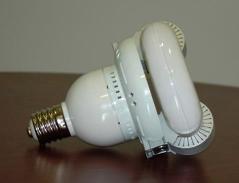 Background
Background
Currently, the topic of LED lighting has become very popular. However, many of the advantages attributed to them are not justified in practice. For example, due to the degradation of crystals, illumination sharply decreases already during one year of operation and there can be no talk of the specified operating time of 60,000 hours.
You can read more about the disadvantages of LED lamps here: "The real advantages and disadvantages of LED lamps, identified experimentally" and in the comments to the article "How are LED lamps".
The question of the payback of LED lamps is very controversial. Meanwhile, there are light sources that currently have better technical characteristics than LEDs and are about three times cheaper than them. It is commercially available induction lamps.
Bit of theory
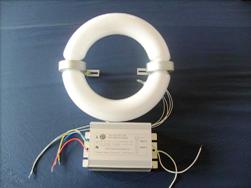 Induction lamps - This is an upgraded fluorescent lamp. Its main difference from other lamps is the absence of incandescent electrodes, which are necessary for ignition of conventional lamps. The glow is due to electromagnetic induction in the gas filling the lamp. To obtain light radiation, a combination of three physical processes is used - electromagnetic induction, electrical discharge in a gas, luminescence of a phosphor during interaction with a gas.
Induction lamps - This is an upgraded fluorescent lamp. Its main difference from other lamps is the absence of incandescent electrodes, which are necessary for ignition of conventional lamps. The glow is due to electromagnetic induction in the gas filling the lamp. To obtain light radiation, a combination of three physical processes is used - electromagnetic induction, electrical discharge in a gas, luminescence of a phosphor during interaction with a gas.
Formed in the flask high frequency electromagnetic fieldwhich ionizes the filling mixture. This leads to the generation of ultraviolet radiation and its conversion by a phosphor into light. The absence of electrodes makes it possible to achieve a fantastic service life of up to 100,000 hours (12 lei of continuous operation), which is 10 times longer than the durability of conventional fluorescent lamps, DRL, DRV and sodium NaNT lamps and 2-3 times LED lights.
Classification of induction lamps
According to the method of placing the induction coil, these lamps are divided into lamps with external induction when the coil is located around the tube, and with internal induction when the coil with the magnetic core is inside the bulb. In addition, there are lamps with a separate ballast and lamps with integrated ballast.
In any case, the induction lamp is an RF transformer (F = 2.65 MHz or 190-250 kHz), where the secondary winding is the RF discharge in the lamp bulb, and the primary winding is connected via an electronic ballast to a 220 / 380V or DC network.
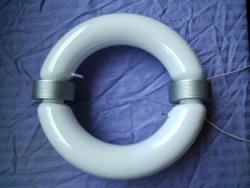 Parameters of induction lamps and their differences from conventional fluorescent
Parameters of induction lamps and their differences from conventional fluorescent
Induction lamps are available at a power of 15, 20, 40, 80, 120, 150, 200, 300, 500 watts. There are even more powerful industrial lamps. There are all the usual forms for any fixtures with lampholders E14, E27, E40 and special ring lamps. Such lamps can work in networks of both alternating and direct current.
A significant advantage of induction lamps over simply fluorescent lamps is the lack of electrodes. This makes the lamp bulb homogeneous and equally balanced in temperature. During long-term operation, the balloon does not crack around the electrodes and the electrode material does not deposit on the lamp balloon.
Therefore, even after prolonged use, induction lamps maintain a luminous flux level of 80-90% of the original. For comparison, the fluorescent lamps we are used to lose by the “end of life” up to 50-60% of their initial brightness, i.e. have a luminous flux level of 40% of the original. Black opaque circles are formed on their cylinders along the balloon and around the electrodes.
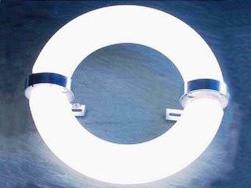 The main advantages of induction lamps over LEDs:
The main advantages of induction lamps over LEDs:
1. Extremely long service life from 60000-150000 hours, which is up to 18 years of continuous operation (60,000 for LED lamps);
2.Light output of more than 80-160 lm / W, for comparison, LED lamps 90-120;
3. High efficiency 0.9 (0.9-0.95 for LEDs);
4. Reduction of the luminous flux by the end of the service life by 10-15% (for LEDs, with a shorter service life, by 20-30%);
5. Large warranty period - 5 years, for LEDs - 2 years;
6. High photo-optical efficiency of 120-200Flm / W. LEDs 40-90;
7. The price is 3-5 times lower compared to an LED lamp of the same power;
8. High color rendering index Ra> 80, i.e. comfortable, soft light, pleasant to the eyes, which can not be said about the LEDs;
9. Low lamp heating temperature, only 40-60 degrees Celsius and a wide range of operating temperatures from -40 to +60;
10. The ability to change the brightness from 30 to 100% using a conventional dimmer for incandescent lamps, with LED lamps this is not possible;
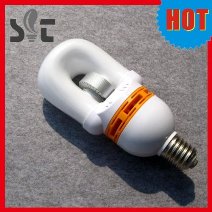 11. High power factor up to 0.95;
11. High power factor up to 0.95;
12. Low content of solid state mercury - several times compared with conventional fluorescent lamps.
13. The average payback period of such lamps at an enterprise operating in two shifts of about 1.5 years for LED lamps is 5 years.
14. Unlike LED lamps, an induction lamp gives a soft and natural light, it is much better able to withstand voltage surges characteristic of domestic networks.
conclusions
So, induction lamps, compared to LEDhave a number of significant advantages. The main advantages are 3-5 times lower price, 2-3 times longer MTBF, longer warranty period, greater light output and more pleasant and natural light. Therefore, at the moment, when choosing between LED and induction lamps (lamps), preference should be given to the latter.
However, I regret to note that the price of an induction lamp with an E27 base with a power of 20 W is approximately 700-1000 rubles, but it has already become ordinary energy saving lamp the same power, costs 100-150 rubles. Make your choice yourself.
See also at e.imadeself.com
:
